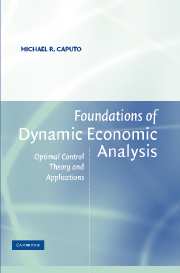Book contents
- Frontmatter
- Contents
- Foreword by Eugene Silberberg
- Preface
- 1 Essential Elements of Continuous Time Dynamic Optimization
- 2 Necessary Conditions for a Simplified Control Problem
- 3 Concavity and Sufficiency in Optimal Control Problems
- 4 The Maximum Principle and Economic Interpretations
- 5 Linear Optimal Control Problems
- 6 Necessary and Sufficient Conditions for a General Class of Control Problems
- 7 Necessary and Sufficient Conditions for Isoperimetric Problems
- 8 Economic Characterization of Reciprocal Isoperimetric Problems
- 9 The Dynamic Envelope Theorem and Economic Interpretations
- 10 The Dynamic Envelope Theorem and Transversality Conditions
- 11 Comparative Dynamics via Envelope Methods
- 12 Discounting, Current Values, and Time Consistency
- 13 Local Stability and Phase Portraits of Autonomous Differential Equations
- 14 Necessary and Sufficient Conditions for Infinite Horizon Control Problems
- 15 The Neoclassical Optimal Economic Growth Model
- 16 A Dynamic Limit Pricing Model of the Firm
- 17 The Adjustment Cost Model of the Firm
- 18 Qualitative Properties of Infinite Horizon Optimal Control Problems with One State Variable and One Control Variable
- 19 Dynamic Programming and the Hamilton-Jacobi-Bellman Equation
- 20 Intertemporal Duality in the Adjustment Cost Model of the Firm
- Index
Preface
Published online by Cambridge University Press: 05 June 2012
- Frontmatter
- Contents
- Foreword by Eugene Silberberg
- Preface
- 1 Essential Elements of Continuous Time Dynamic Optimization
- 2 Necessary Conditions for a Simplified Control Problem
- 3 Concavity and Sufficiency in Optimal Control Problems
- 4 The Maximum Principle and Economic Interpretations
- 5 Linear Optimal Control Problems
- 6 Necessary and Sufficient Conditions for a General Class of Control Problems
- 7 Necessary and Sufficient Conditions for Isoperimetric Problems
- 8 Economic Characterization of Reciprocal Isoperimetric Problems
- 9 The Dynamic Envelope Theorem and Economic Interpretations
- 10 The Dynamic Envelope Theorem and Transversality Conditions
- 11 Comparative Dynamics via Envelope Methods
- 12 Discounting, Current Values, and Time Consistency
- 13 Local Stability and Phase Portraits of Autonomous Differential Equations
- 14 Necessary and Sufficient Conditions for Infinite Horizon Control Problems
- 15 The Neoclassical Optimal Economic Growth Model
- 16 A Dynamic Limit Pricing Model of the Firm
- 17 The Adjustment Cost Model of the Firm
- 18 Qualitative Properties of Infinite Horizon Optimal Control Problems with One State Variable and One Control Variable
- 19 Dynamic Programming and the Hamilton-Jacobi-Bellman Equation
- 20 Intertemporal Duality in the Adjustment Cost Model of the Firm
- Index
Summary
Forward-looking individuals recognize that decisions made today affect those to be made in the future, at least in part, by expanding or contracting the set of admissible choices, that is, by lowering or raising the cost of a future choice. Such intertemporal linkages reside at the core of all dynamic processes in economics. Consequently, mathematical methods that account for such intertemporal linkages are fundamental, in principle, to all economic decisions. This book presents an introductory but thorough exposition of the fundamental mathematical formalism used to study continuous time dynamic economic processes and to interpret dynamic economic behavior, namely, optimal control theory and its ancillary techniques.
The style of presentation distinguishes the book from several other excellent texts on the subject. First of all, there is a continual emphasis on the economic interpretation of the mathematics and the models, aided dramatically by way of the method of comparative dynamics, from both a primal and dual point of view. In my twelve years of teaching the course upon which the book is based, I have found that this approach permits the students to garner a deeper conceptual understanding of intertemporal economic models. One of the keys to a deeper conceptual understanding, I believe, is the introduction of the dynamic envelope theorem relatively early in the presentation of optimal control theory. This strategy paves the way for many of the succeeding chapters of the book to be built around this vital theorem, and not only complements the aforementioned emphasis on economic interpretation and conceptualization, but also leads to motivated proofs of the transversality conditions, an area long on technicalities and short on intuition.
Information
- Type
- Chapter
- Information
- Foundations of Dynamic Economic AnalysisOptimal Control Theory and Applications, pp. ix - xiiPublisher: Cambridge University PressPrint publication year: 2005
Accessibility standard: Unknown
Why this information is here
This section outlines the accessibility features of this content - including support for screen readers, full keyboard navigation and high-contrast display options. This may not be relevant for you.Accessibility Information
- 1
- Cited by
